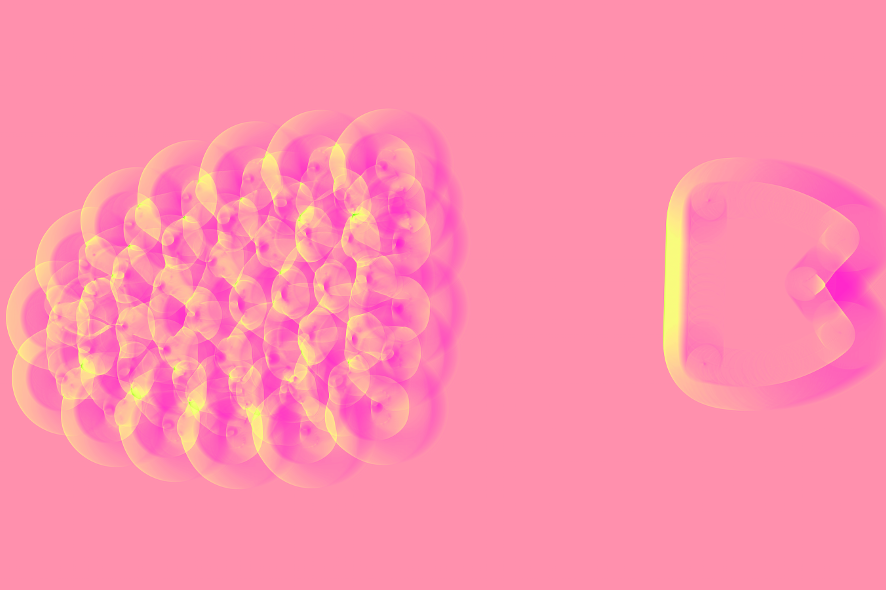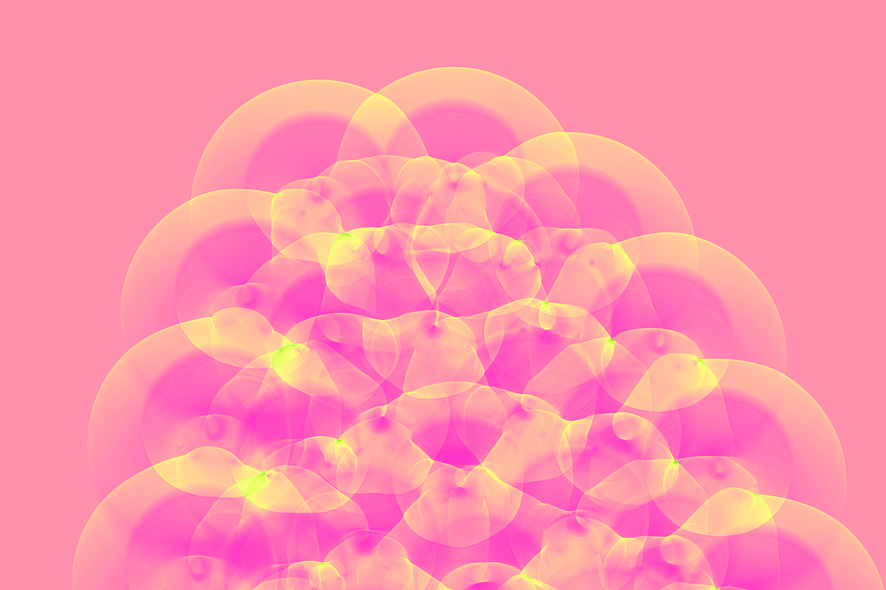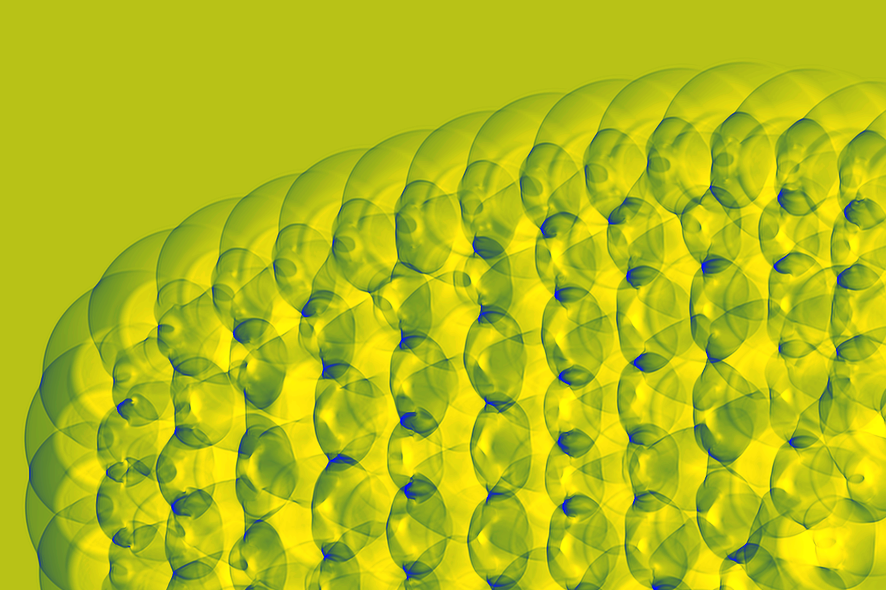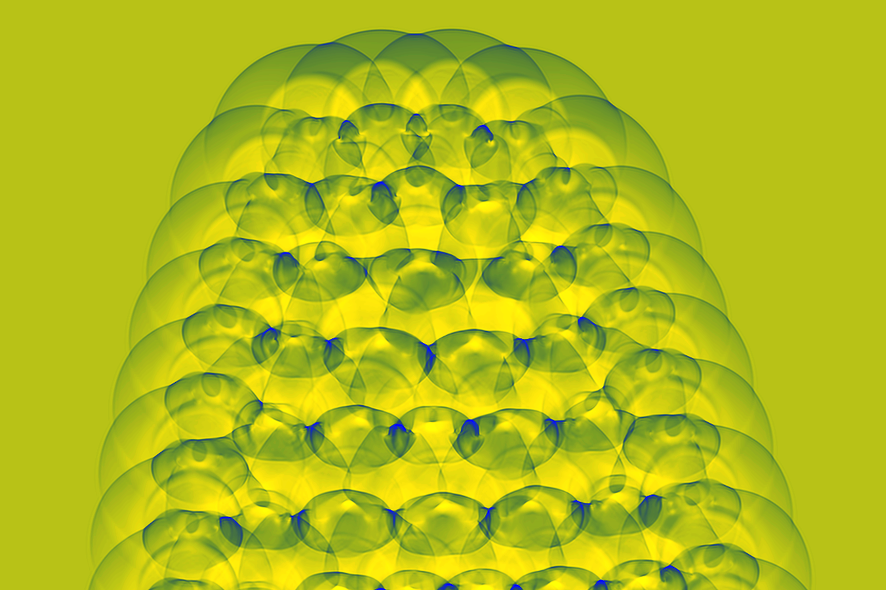When wearing shoes and performing acts such as standing and walking, a pressure field that is invisible to the naked eye is generated on the contact surface, and this certainly continues to affect the surrounding areas. The shoe is not just a device to support walking; it is also a medium to propagate the wearer’s existence and identity in the form of mild pressure.
A small storm is raging in the micro space around the shoe sole. Wind pressure generated by walking blows the mite off the carpet. Converting to macro scale, it is similar to the phenomenon in which human beings are blown down by the air pressure generated during wartime air raids. Through simulation and visualization, we may obtain a wide range of perception connecting the micro to the macro world. During the 2016 Ars Electronica Festival the artist Akira Wakita presentes several times in person his artwork “Scalar Fields” at Deep Space 8K.
In an interview he told us what it’s all about with the shoes, why he is so fascinated by the movement of air and what inspired him to this work.

In an other work from you “Furnished Fluid”, which was exhibited at the Ars Electronica Center, you visualized the airflows around furniture. Now with “Scalar Fields” you visualize the pressure field around the soles of shoes. What excites you about the movement of air?
Akira Wakita: Since I was a kid, I felt a sense that the things visible to my eyes might be different from their true entity. It has been my intuition that an abundance of power forming this world exists in the invisible parts. In the spirit of Japanese Zen, there is a word “shin-kuu-myouu.” It means that in true empty state, it is full of rich energy that creates various things. Another familiar concept of Japanese “Ma” is to the idea of finding out the richness within the spaces between substances. This type of idea is hard to grasp but we can actually sense it by simulating air flows.
Furnish Fluid is a visualization of air flows from their velocities, and it makes us realize that there are plentiful microcosms coming from vortex and turbulence. On the other hand, Scalar Fields is a visualization of pressure. This artwork shows that no matter how small it is, one pressure surely affects others and that chain of effects leads to bigger phenomenons. If you walk away from here, there is a history that you were standing here in the form of propagation patterns of pressure. Human eyes cannot detect them but people might feel the hint from those patterns. In this way, simulation of air and visualization renew our perspectives. That’s why this project is interesting.

Is the propagation of pressure in the air by the step with a shoe a metaphor for something? What was the inspiration for this work?
Akira Wakita: The astronaut Neil Armstrong’s “One Small Step” is very famous. This step signifies people’s frontier spirit and symbolizes historic achievement as space pioneers. However, everyone can take such a “first step”. The world can surely be changed by that one step. This artwork submits an effect on people’s actions by pressure propagation, from a physical perspective, and suggests that one step can certainly affect the world through simulation and visualization. Physical simulation is considered something unsentimental but if you stand at a different viewpoint, it can be very emotional and provocative.
You have measured and visualized the air flows with a specially developed fluid simulation software. How exactly can one imagine this software? How does it work?
Akira Wakita: I make my artwork using software of fluid simulation that I uniquely developed. All source code is written from scratch and took 3 years to develop including study phase of computational fluid dynamics. Since the study of this field is extremely difficult, I could not create everything by myself so I received mentoring from active physicists in the field.
The software is created on the basis of mathematical models of fluid dynamics, called Navier-Stokes equations. In a simple description, 4 types of forces are the keys to calculating behavior of fluids. They are inertia (a force that keeps things in motion), viscosity (a force that keep things at a location), pressure gradients, and external forces. I divided space into detailed grids and calculated those forces at every grid point. These values are calculated by very short time steps (for example, every 0.000001 second), and simulated by repeating the process that moves particles on the basis of the values from calculations in each grid.
In the case of Furnish Fluid, calculations were performed in real time by using the CPU but in Scalar Fields, calculations were parallel processed with the GPU to cope with the 8K resolution of Deep Space. However, the amount of calculation is still huge. Even with the latest PC model, execution speeds were at 0.5 frames per second. The movie is generated by thousands of still images outputted from those processes. After one simulation is executed, generating about 90 seconds of visualization takes roughly 7 hours. Then, the routine is repeated until the results are sensuously satisfying. It is quite a laborious work.

In your work you are using elegant Italian shoes. Was it important which shoes the air pressure produce?
Akira Wakita: Many people have seen the ripples when a pebble is dropped into a pond. This phenomenon shows how pressures are propagated through the water. Then I thought that if a simple phenomenon like this and a complicated sole of a shoe are linked, an interesting simulation can be created. I researched various shoes, and found that shoes from the Italian brand, TOD’S, are distinctive with their soles having hodgepodge-like pebbles. In an actual simulation, at first, the patterns are like ripples made when many pebbles are dropped into the water surface, but next, the patterns affect each other. This effect emerged brilliant unpredictable patterns. It hooks the viewer’s bare feelings and might help to point out how the world is complicated and enormously striking. These shoes fit what I wanted to represent.
The visualization can be seen during the Ars Electronica Festival in Deep Space 8K as wall and floor projection. How would you describe this aesthetic representation of the propagation of pressure?
Akira Wakita: There are tiny storms within the micro space around the soles. Thus, our every step would blow off the mites on the carpet. In human scale, we can feel the sound pressure from a strong bass and a great speaker, and we can enjoy the great sounds of an orchestra because of the pressure. When it is converted to macro scale, it is true that various kinds of “blowing- off phenomenon”, coming from a typhoon or an explosion, is equally caused by a pressure. Viewers can experience “little creature’s eye” and think of micro phenomenon in this special Deep Space 8K space. At the same time, people sense a reality that a pressure field is always there, like everywhere, every time. When Deep Space 8K and this artwork are combined, I assure you a broad experience from the connection between the micro and macro.

The visualization is also accompanied with a marvelous sound experience. The music is by Tetsuya Komuro. Was the music especially composed for this visualization? How was the collaboration?
Akira Wakita: Tetsuya Komuro composed the music for this artwork exclusively, and the music influenced my decision to remake both simulation and visualization. Through this loop, the production process proceeded. Interacting with each other, both the composition and simulation sought a landing spot for completion. Mr. Komuro is like a wizard of modulation, and his work is distinctive in the change of keys between minor codes to major codes. On the other hand, in my fluid simulation, there are one singularities. That is a point where ordered laminar flow changes to chaotic turbulence. In this artwork, combination of those two points exquisitely is a key to this collaboration. It could be said that this piece is a dance music by visualized fluid and synthesizer or also a new type of bolero.
The reason for the collaboration between me and Mr. Komuro is Isao Tomita, who passed away last May. Tomita Sound Cloud, which he produced, at Ars Electronica Festival in 1984 was the epoch that enhanced artistry and sociality of electro music to its utmost limit. As one of the Japanese artists given a chance to present artwork at the festival this year, I decided to produce something that mourns Mr. Tomita. Then, I interviewed to ask for collaborations with some musicians, and bumped into Mr. Komuro. The interview with him went very well. When he was young, he experienced Mr. Isao Tomita’s performance at World Exposition, and it was a trigger to form a synthesized pop music group, called TM Network. Moreover, he has the passion for Ars Electronica Festival where Sound Cloud was announced. With such connections, I feel that this work represents the pinnacle of the sounds of a synthesizer.

The theme of this year’s Ars Electronica Festival is called “RADICAL ATOMS and the alchemists of our time”. Would you describe yourself as a modern alchemist? What qualities does an alchemist of our time need?
Akira Wakita: In my interpretation, an alchemist is a person who provides a magical moment with his (or her) physical, chemical, electronic, and biological knowledge. With that definition, I could say I am one of the alchemists of today. Since the 17th century, alchemy and science have been treated separately, and it has shrunk people’s creativity. However, in these days, the flow of Art&Science tries to reintegrate them and helps to recover the freedom of creation across the limitations between different fields and specialities. It makes it possible for the society to create a new magic moment.
Baien Miura, a Japanese philosopher left a wise remark about the bilateral characters of a magic moment: “Don’t be surprised when a dead tree bloomed, be surprised a living tree bloomed.” The former means that it seems an unfeasible thing is happening with rational principle. However, I consider the latter one to be more important. It is not surprising that cherry blossoms bloom in March, but we should know that this ordinary phenomenon is still remarkable. We live in an era when the heart must feel that remarkableness; in other words, a sense of wonder is essential in today’s society. Alchemists today should share this type of mindset to the society. Changing the world means changing people’s perceptions.


Akira Wakita conducts studies regarding the theme of “physicality,” focusing on real time images produced by physical simulation on one hand and materials that can control colors on the other hand. In recent years, he developed original software based on fluid-dynamic and thermodynamic models, striving for visualization across science and art.
During the 2016 Ars Electronica Festival the artist Akira Wakita presentes several times in person his artwork “Scalar Fields” at Deep Space 8K. Here you get more information: https://ars.electronica.art/radicalatoms/en/deep-space-8k-scalar-fields/
